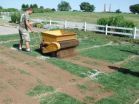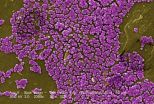(Press-News.org) EAST WAREHAM, MA—Cranberry is an important commercial crop in states such as Massachusetts, Wisconsin, New Jersey, Washington, and Oregon. Insects and disease can pose serious problems for growers trying to realize profits in heavy cranberry production regions. Since cranberry is a perennial crop, pest damage can have a particularly significant negative impact in the next growing season.
By studying feeding preferences of insects, entomologists have reported that several insects prefer some cranberry cultivars over others. For instance, several insect herbivores have been anecdotally reported to prefer 'Howes' cranberry leaves over those of 'Early Black'. In a recent study published in the Journal of the American Society for Horticultural Science, scientists reported on a series of studies they designed to determine whether these anecdotal reports were accurate and to compare phenolic profiles in the foliage of 'Early Black' and 'Howes' for compounds that differ in concentration and could be possible feeding deterrents.
The scientists conducted bioassays to determine the feeding preferences of three cranberry pests. Gypsy moth larvae, cranberry weevil adults, and red-headed fleabeetle were studied in late June, early July, and early August, respectively, when they were at their most active on the bog. According to the research, gypsy moth larvae demonstrated a significant feeding preference for 'Howes' over 'Early Black'. Red-headed flea beetle adults demonstrated a similar, but not statistically significant, trend, whereas cranberry weevil preferred neither cultivar.
"Compounds giving rise to six peaks in the phenolic profile were significantly greater in concentration in 'Early Black' than 'Howes' on at least one of three sampling dates during the growing season", noted the study's corresponding author Justine Vanden Heuvel. "Five of these compounds were isolated from leaves harvested at the June time point coinciding with gypsy moth infestation and identified as: 5-O-caffeoylquinic acid, 3-O-p-coumaroylquinic acid, 5-O-p-coumaroylquinic acid, quercetin-3-O-galactoside, and quercetin-3-O-rhamnoside."
Vanden Heuvel said that the data suggests that these compounds warrant further investigation as possible insect-feeding deterrents. "The compounds identified in this study should be investigated further to determine their ability to reduce feeding and/or growth of foliage feeders in cranberry. If a feeding deterrent is identified, this deterrent could have potential as a screening method for new cranberry cultivars. Breeding schemes and cultural practices could also be investigated to increase the presence and concentration of the deterrent in cranberry leaves."
INFORMATION:
The complete study and abstract are available on the ASHS Journal of the American Society of Horticultural Science electronic journal web site: http://journal.ashspublications.org/cgi/content/abstract/135/6/494
Founded in 1903, the American Society for Horticultural Science (ASHS) is the largest organization dedicated to advancing all facets of horticultural research, education, and application. More information at ashs.org
Pest preferences for cranberry cultivars determined
6 compounds found in cranberry leaves may naturally reduce insect feeding, growth
2011-06-23
ELSE PRESS RELEASES FROM THIS DATE:
Optimal topdressing applications for athletic fields determined
2011-06-23
EAST LANSING, MI—The practice of "topdressing" athletic fields with sand has been used by turfgrass professionals for years. Topdressing is essential to maintaining safe and healthy turf, and using porous sand allows the turfgrass system to retain the necessary pore space for adequate drainage, even in heavy foot traffic.
While sand-based athletic fields may be preferred by schools and municipalities, conversion to a sand-based system is expensive. Complete renovation is often cost-prohibitive and renders the field temporarily unusable. Because of these drawbacks, complete ...
Angioplasty with stents may be safe in long-term for low-risk heart patients
2011-06-23
Heart bypass surgery is considered the gold standard for most patients with left main coronary artery disease, one of the most serious types of heart disease and one that affects thousands.
But a new UCLA study reports favorable long-term outcomes for lower-risk patients with this condition who underwent angioplasty with medication-coated stents, rather than bypass surgery.
A more minimally invasive procedure than surgery, angioplasty is performed by snaking a tiny wire up through an artery in the groin to the blocked area of the heart. The clogged artery is cleaned ...
Slowing the spread of drug-resistant diseases is goal of new research area
2011-06-23
In the war between drugs and drug-resistant diseases, is the current strategy for medicating patients giving many drug-resistant diseases a big competitive advantage?, asks a research paper that will be published in the Proceedings of the National Academy of Sciences. The paper argues for new research efforts to discover effective ways for managing the evolution and slowing the spread of drug-resistant disease organisms. The ultimate goal of this new research effort is to develop a new science-based model for drug-resistance management that will inform treatment guidelines ...
Salamon & Seaber Tests Confirm that URALCHEM's Methods of Fertilizer Analysis Compare with Those of EC Regulation Methods
2011-06-23
URALCHEM, OJSC announces the successful completion of round robin tests of the company's fertilizer carried out by Salamon & Seaber, one of the leading UK analytical laboratories, with the participation of URALCHEM specialists. The main objective of the product sample analysis was to compare the results obtained by applying the methods used in URALCHEM laboratories for quality control to those used by Salamon & Seaber. The test results have proved that the methods certified by Rosstandard (the Russian Federal Agency for Technical Regulation and Metrology) for the ...
Artificial light quality affects herbivore preference for seedlings
2011-06-23
OSAKA, JAPAN—In horticultural production, growers often depend on systems that use artificial light to produce high-quality transplants. Although the systems are efficient, fluorescent lamps can produce plants with shorter shoots than those grown under natural light. Studies have indicated that this reduced shoot elongation is due to the high red:far red ratio of typical commercial fluorescent lamps, which emit little far red irradiation.
In natural environments a reduction in the red:far red (R:FR) ratio resulting from the absorption of red light by neighboring vegetation ...
Early-season strawberry tested in high elevation conditions
2011-06-23
LOGAN, UT—In response to increased awareness generated by the expanding local foods movement, demand for fresh strawberries has increased throughout the United States. The fresh market strawberry industry in the U.S. flourishes in California and Florida—states with ideal weather conditions and long growing seasons. Even with challenging growing conditions, small-scale strawberry production operations succeed in other areas of the country, particularly near urban areas where local produce commands premium prices at market.
Ideal growing conditions for strawberries occur ...
Anelli Xavier Announces Albany, New York, Office Location
2011-06-23
Tom Anelli, known as The DWI Guy, and his team of drunk driving defense attorneys at Anelli Xavier announce the opening of their Albany, New York, law office at the following address:
Anelli Xavier, PC
90 Swan Street
Albany, NY 10027
Map and directions
While the law firm continues to represent clients throughout the state of New York, this expansion allows the firm's attorneys more flexibility in meeting with its Albany DWI clients.
The law firm also upgraded and moved its Syracuse location to:
Anelli Xavier, PC
269 W. Jefferson Street, 2nd Floor
Syracuse, ...
Researchers clock the speed of brain signals
2011-06-23
NEW YORK (June 22, 2011) -- Two studies featuring research from Weill Cornell Medical College have uncovered surprising details about the complex process that leads to the flow of neurotransmitters between brain neurons -- a dance of chemical messages so delicate that missteps often lead to neurological dysfunction.
A recent Nature Neuroscience study led by Dr. Timothy Ryan, professor of biochemistry at Weill Cornell Medical College, demonstrates that individual neurons somehow control the speed by which they recycle synaptic vesicles that store neurotransmitters before ...
Fungicides may not increase corn yields unless disease develops
2011-06-23
WEST LAFAYETTE, Ind. - Unless a corn crop is at risk of developing fungal diseases, a Purdue University study shows that farmers would be smart to skip fungicide treatments that promise increased yields.
Kiersten Wise, an assistant professor of botany and plant pathology, said fungicides used in fields where conditions were optimal for fungal diseases improved yields and paid for themselves. In fields where fungal diseases are unlikely to develop, however, applying a fungicide is likely a waste of money.
"About five years ago, we never used fungicides in hybrid corn. ...
Toronto Estate Planning Explained
2011-06-23
Preparing your estate plan
Creating your estate plan will require an estate lawyer who will help you to prepare a structured agreement detailing the passing of your worldly goods to your intended beneficiaries.
Your estate plan should provide a clear outline of your intended objectives for the transfer of your estate. The intention of the process is to provide a semblance of clarity to proceedings while preventing costly potential problems such as executor disputes.
The documented agreement should contain a detailed breakdown of your liabilities as well as your ...
LAST 30 PRESS RELEASES:
Strategic river sensors could have forewarned of Texas Camp flood disaster
Drone sampling of whale breath reveals first evidence of potentially deadly virus in Arctic
Roman soldiers defending Hadrian’s Wall infected by parasites, study finds
Pinochet’s prisoners were tormented with music but still found solace in it, a new book reveals
Fertility remains high in rural Tanzania despite access to family planning
AI-assisted device can improve autism care access
Kinetic careers
Uncovering how parasitic plants avoid attacking themselves to improve crop resistance
Nanoparticle vaccine strategy could protect against Ebola and other deadly filoviruses
Study finds brain care score can predict risk of stroke across racial groups
Key lung immune cells can intensify allergic reactions
Do hormones explain why women experience more gut pain?
New materials conduct ions in solids as easily as in liquids
Breakthrough of the Year: Renewable energy begins to eclipse fossil fuel-based sources
LLM use is reshaping scientific enterprise by increasing output, reducing quality and more
Introducing LightGen, a chip for ultra-fast, ultra-efficient generative AI
Astronomers see fireworks from violent collisions around nearby star
ACC/AHA issue new guideline on managing congenital heart disease in adults
Cosmic crash caught on camera
Is talented youth nurtured the wrong way? New study shows: top performers develop differently than assumed
Ants: An untapped resource in the development of antibiotics?
Archaeologists use AI to create prehistoric video game
Mitochondria migrate toward the cell membrane in response to high glucose levels
Tiny viral switch offers hope against drug-resistant bacteria
Most parents aware of early peanut introduction guidelines, but confused about details
HPV vaccine can protect against severe lesions of the vulva and vagina
Virtual care provision and emergency department use among children and youth
Quadrivalent HPV vaccine and high-grade vulvovaginal lesions
Insights into dry eyes gained from stem cell-derived tear glands
Researchers identify 166 human pluripotent stem cell lines available for use in clinical applications
[Press-News.org] Pest preferences for cranberry cultivars determined6 compounds found in cranberry leaves may naturally reduce insect feeding, growth



